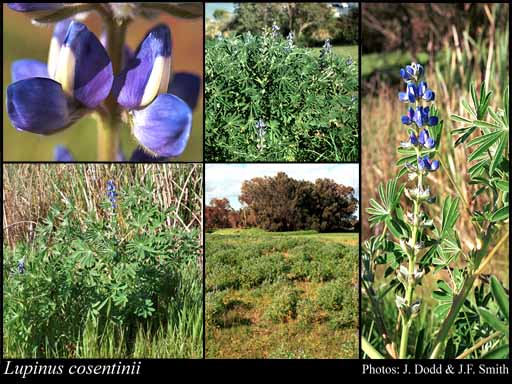- Reference
- Fl.Sicul.Prod. 2:398-399 (1828)
- Conservation Code
- Not threatened
- Naturalised Status
- Alien to Western Australia
- Name Status
- Current
Robust, much-branched annual, herb, 0.2-1.4 m high. Fl. blue, Aug to Nov. Sand, loam. River edges, swamps, roadsides.

Scientific Description
Erect, herb. Stems flattened or winged, not spiny, hairy; pustules or glands absent. Leaves or phylloclades clearly present, compound, alternate, continuous with stem, 70-150 mm long, hairy, with simple hairs, flat with flat margins; margins entire; tubercles absent, leaflets 9-10, palmately arranged, terminal leaflet absent; pustules or glands absent. Stipules present and persistent to older leaves, 10 mm long, without glands, ribless. Pedicel present, 4-5 mm long, hairy. Bracteoles present and persistent, 4-5 mm long, hairy, not striate. Calyx 8-9 mm long, not accrescent, hairy, with simple hairs, ribless; pustules or glands absent. Corolla 14-21 mm long, uniformly coloured, blue; claws present; standard 14-15 mm long, glabrous, not auriculate, wings 13-14 mm long, not auriculate, keel 12-17 mm long, beaked, not auriculate, glabrous. Stamens ten; anthers 1.2-1.7 mm long, at two different levels (filaments alternately long and short); filaments united in a closed sheath, 10-13 mm long. Ovary stipitate, hairy or glandular; style 15-21 mm long, hairy or glandular towards the base, bearded (with a tuft of hairs at apex), terete. Fruit dehiscent (a pod or follicle), sessile or subsessile, constricted between the seeds, flat or compressed, not beaked. Flowers in August, September, October and November. Occurs in the Eremaean and South-West Botanical Province, in the Carnarvon, Geraldton Sandplains, Avon Wheatbelt, Jarrah Forest, Mallee, Warren, Esperance and Swan Coastal Plain IBRA regions.
Distribution
- IBRA Regions
- Avon Wheatbelt, Carnarvon, Esperance Plains, Geraldton Sandplains, Jarrah Forest, Mallee, Swan Coastal Plain, Warren, Yalgoo.
- IBRA Subregions
- Fitzgerald, Geraldton Hills, Katanning, Lesueur Sandplain, Merredin, Northern Jarrah Forest, Perth, Recherche, Southern Jarrah Forest, Tallering, Warren, Western Mallee, Wooramel.
- IMCRA Regions
- Central West Coast, Leeuwin-Naturaliste.
- Local Government Areas (LGAs)
- Boyup Brook, Busselton, Carnarvon, Chittering, Cockburn, Coorow, Dandaragan, Esperance, Fremantle, Gingin, Goomalling, Gosnells, Greater Geraldton, Harvey, Irwin, Jerramungup, Kulin, Mandurah, Manjimup, Melville, Mingenew, Mundaring, Murray, Nedlands, Northampton, Perth, Plantagenet, Serpentine-Jarrahdale, Shark Bay, South Perth, Stirling, Tammin, Victoria Park, Wanneroo, Waroona, West Arthur, Yalgoo, York.
Management Notes (for the Swan NRM Region)
Alternative Names. Western Australian Blue Lupin.
General Biology. Growth form. Herb. Life form. Annual. Reproduction. Seed. Dispersal. Planting for agriculture, water, soil movement. Toxicity. Stubble and large quantities of seed can cause poisoning in stock. Seedbank persistence. Some dormancy.
Notes. Has a well-established root system including a strong taproot. Capable of fixing nitrogen. Seed germinates in autumn, plants grow through winter and spring, and die with the onset of summer drought. Genotypes of Lupinus cosentinii appear to be more tolerant of calcareous soils than L. angustifolius.
Additional information. Origin. Mediterranean, southwestern Europe. History of use/introduction. Widely cultivated as a grain legume crop, animal fodder. Similar exotic species. Lupinus angustifolius.
Suggested method of management and control. Hand remove scattered plants prior to flowering. Spray dense infestations with metsulfuron methyl 0.1g/15 L (2-3 g/ha) + wetting agent. Larger areas can be treated with more selective herbicides such as 200 g/ha Lontrel® or 50 g/ha Logran® (based on 500 L of water/ha). For spot spraying use 4 g Lontrel® or 1 g Logran® in 10 L of water + wetting agent. Glyphosate is relatively ineffective. Read the manufacturers' labels and material safety data sheets before using herbicides. For further information consult the Australian Pesticides and Veterinary Medicines Authority to determine the status of permits for your situation or state.
Management Calendar
| Calendar Type | Jan | Feb | Mar | Apr | May | Jun | Jul | Aug | Sep | Oct | Nov | Dec | Comments |
|---|---|---|---|---|---|---|---|---|---|---|---|---|---|
| Germination | Y | Y | O | ||||||||||
| Active Growth | Y | Y | Y | Y | Y | Y | |||||||
| Flowering | Y | Y | Y | Y | |||||||||
| Fruiting | Y | Y | |||||||||||
| Manual Removal | Y | Y | Y | Y | |||||||||
| Herbicide Treatment | Y | Y | Y | Y |
Legend: Y = Yes, regularly, O = Occasionally, U = Uncertain, referred by others but not confirmed.
References
- Brand, J.D., Tang C. & Rathjen, A.J. (2002) Screening rough-seeded lupins (Lupinus pilosus Murr. and Lupinus atlanticus Glads.) for tolerance to calcareous soils. Plant and Soil, Volume, 245 (2): 261-275.
- Brown, K. & Brooks, K. (2002) Bushland Weeds: A Practical Guide to their Management. Environmental Weeds Action Network, Greenwood.
- Emms, J., Virtue, J.G., Preston, C.T. & Bellotti, W.D. (2005) Legumes in temperate Australia: A survey of naturalisation and impact in natural ecosystems. Biological Conservation, 125: 323-333.
- Hussey, B.M.J., Keighery, G.J., Dodd, J., Lloyd, S.G. & Cousens, R.D. (2007) Western Weeds. A guide to the weeds of Western Australia. 2nd Edition. The Plant Protection Society of Western Australia, Victoria Park.
- Moore, C.B. & Moore, J.H. (2002) Herbiguide, the pesticide expert on a disk. Herbiguide, PO Box 44 Albany, Western Australia, 6330.
- Moore, J.H. & Wheeler, J. (2008) Southern weeds and their control. DAFWA Bulletin 4744.
- Pigott, J.P. (1989) Lupin control in remnant woodland. Australian Weed Research Newsletter, 38: 59-61.